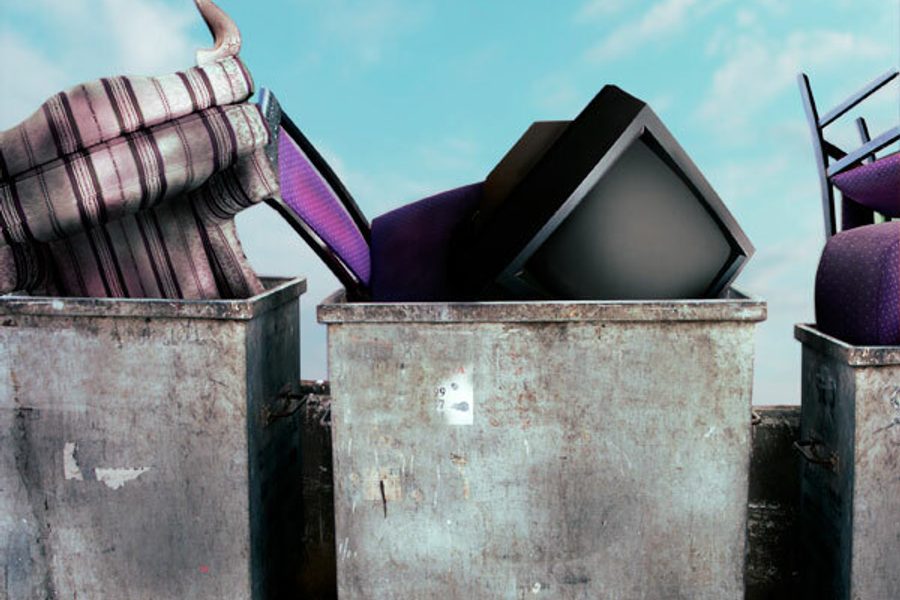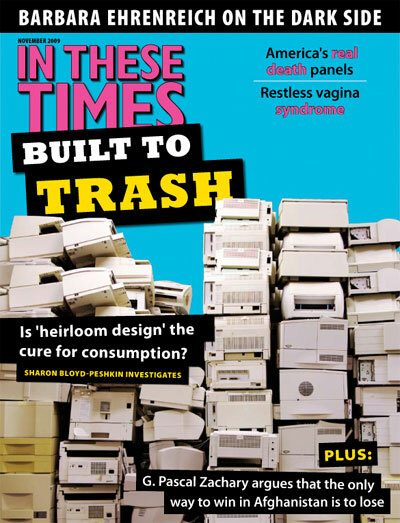
As the middle-class daughter of a refugee mother and a Depression-era father, I grew up straddling two worlds. My parents could afford much more than they were willing to buy. Most things that broke could be and were repaired. My German grandmother’s aphorisms lingered in the air: “Waste not, want not,” “A penny saved is a penny earned,” “A stitch in time saves nine.”
By the time my own children were born, America was flooded with cheap and cheaply made goods. So while my parents continued working at the sturdy antique desks they inherited from my grandparents and sleeping beneath a hand-crocheted bedspread, my children and their friends became the first and last owners of a seemingly endless supply of plastic toys and particle-board furniture.
I was part of the transitional generation. Building blocks were still made of wood. Comforters were still filled with down. I recall the meticulously machined pencil sharpeners with “made in West Germany” stamped on their sides that lasted until I lost them. Even the cheap items – the ones “made in Japan” – tended to hold up pretty well.
Now nearly everything is produced in China and made to be discarded. According to a 2008 report by the Economic Policy Institute, the United States imported $320 billion in Chinese goods in 2007. In that year alone, this country imported $26.3 billion in apparel and accessories, $108.5 billion in computers and electronic products, and $15.3 billion in furniture and fixtures from China.
The manufacture, distribution and disposal of an ever-growing mountain of short-lived consumer goods has taken an enormous environmental toll. Annie Leonard’s website “The Story of Stuff,” which has garnered more than 7 million views in less than two years, has helped spread awareness of that cost far beyond the usual environmentalist circles.
We can’t, however, only blame the quantity and quality of Chinese goods for the environmental and other consequences of this transoceanic factory-to-waste stream. For that we can blame the two horsemen of the modern consumer apocalypse: functional obsolescence and fashion obsolescence.
Functional, or planned obsolescence is the purposeful decision by designers and manufacturers to ensure things don’t last, so that consumers must buy new ones. Fashion obsolescence is the related decision to offer new features and aesthetic changes to entice consumers to discard their old items in favor of updated and supposedly better ones.
Ironically, product obsolescence was once seen as the remedy for what ailed our country. Lizabeth Cohen, chair of the History Department at Harvard University and author of A Consumers’ Republic: The Politics of Mass Consumption in Postwar America (Vintage, 2003), traces the origins of mass consumption to the period immediately before and after World War II, when a demand-driven economy was seen as the key to our nation’s recovery and prosperity.
“In the 1940s and ’50s, there was a much closer connection between consumer demand and factories and jobs,” Cohen says. “That was a completed circle more than it is today. When people were buying things, they were buying things that were made by American workers.”
The only way to guarantee continued demand was to ensure that people would keep replacing the things they owned. The literature on planned obsolescence makes frequent reference to statements by industry analysts and strategists of that era. “Our enormously productive economy … demands that we make consumption our way of life, that we convert the buying and use of goods into rituals, that we seek our spiritual satisfaction, our ego satisfaction, in consumption,” retailing analyst Victor Lebow said in 1948. “We need things consumed, burned up, worn out, replaced and discarded at an ever increasing rate.”
This applied to male as well as female consumers, and to styling lines on cars as well as hemlines on skirts. Allied Stores Corporation’s Chairman B. Earl Puckett, speaking to fashion industry leaders in 1950, said, “Basic utility cannot be the foundation of a prosperous apparel industry. We must accelerate obsolescence.” And General Motors’ design chief Harley Earl said in 1955, “The creation of a desire on the part of millions of car buyers each year to trade in last year’s car on a new one is highly important to the automobile industry.”
Business people and politicians weren’t the only ones pushing this idea, Cohen says. “Labor really bought into this package. Purchasing power was the answer to how people would be employed and have a better life. Consumers would fuel the powers of factories that would provide jobs that would put money in peoples’ pockets.”
Since then, Cohen argues, we’ve conflated our concepts of ourselves as good consumers and as good citizens. The idea of consumption as our country’s economic engine continues to this day. Indeed, after the attacks of September 11, 2001, President Bush implored Americans to go shopping. And frugal as I am and as green as I try to be, during the recent economic downturn I’ve found myself feeling that every major purchase I make is a perverse kind of civic duty. The notion of the citizen-as-consumer clearly runs deep.
But things have changed since the 1940s and ’50s. “When people were making goods that lasted [back then], they were benefiting from the explosion of global capitalism and the expanding of markets,” Cohen says. “Now that we have this global recession, it’s problematic. Where do these companies go if they are going to build goods that last? How do they profit if they don’t sell new goods? I don’t know the answer to this, but it’s a problem that policy makers, economic planners, labor unions – everybody has to think about.”
A radically obvious idea
Although the greening of the American consumer has fostered some deceptive greenwashing campaigns seeking to capitalize on our good intentions, it has also made it possible for us to make better ecological and economic choices.
A host of clever websites now enables consumers to calculate their own ecological footprints and offer advice on how to reduce the toll. These include:
MyFootprint.org, where you can find out how many Earths would be necessary if everybody on the planet shared your lifestyle;
H20Conserve.org, where you can tally your water footprint;
Wattzon.com, where you can calculate the energy required to sustain your lifestyle.
Some of these calculations become conceptually complex as they try to measure the energy required for the extraction and transportation of raw materials, and the manufacturing, distribution and ultimate disposal of products. It can all get abstract quite quickly, but there’s a far simpler message embedded in all that complexity: Buy stuff that lasts.
Saul Griffith, a 2007 MacArthur Fellow, serial inventor and co-founder of WattzOn, refers to this as “heirloom design” – a term he introduced during a talk at the February 2009 Greener Gadgets conference in New York. The best way to lower the quantity of energy required to manufacture and distribute consumer goods, he argues, is to make those products not only durable, but repairable and upgradable.
Griffith shares this radically obvious idea with Tim Cooper, head of the Centre for Sustainable Consumption at Sheffield Hallam University in Sheffield, England, and editor of the forthcoming book, Longer Lasting Solutions (Gower, June 2010). The Centre, which Cooper founded in 1996, conducts research into consumers’ behavior as well as the environmental effects of the choices they make.
Cooper argues for “product life extension” – making things more durable, using them properly, and ensuring they are maintained, repaired, upgraded, and reused. A key obstacle, he says, is the perception (supported by public policies) that higher levels of consumption yield greater happiness. After all, an increase in the GNP is considered healthy for the economy and can only be achieved if consumers increase their spending.
Cooper calls for “slow consumption,” the consumer purchasing equivalent of the Slow Food movement (which seeks to build consumer awareness and appreciation of food and its connection to community and the environment). “The issue to address is what kind of economy is going to be sustainable in its wider sense – economically, environmentally and socially,” he says. “The current economy is not sustainable. The sheer throughput of energy and materials cannot be continued.”
If products were more durable, Cooper argues, some jobs lost due to the decrease in consumption would be offset by the addition of more highly skilled maintenance and repair jobs. And whereas the lost jobs might be overseas, the repair jobs would be local. “We need to look at new business models that move away from manufacturing and selling more and more products,” he says. Such models might include “products that last longer but have associated services attached to them, so that the supplier guarantees to maintain, repair and upgrade the products for a certain period.”
This might be a hard sell for consumers, however. Cooper cites the results of a survey in which British homeowners were asked what they considered the disadvantages of longer-lasting appliances. Twenty-three percent stated concerns about price, while 30 percent said they feared these products would become “out of date.” He found that consumers were often disinclined to have products repaired because of the high cost of labor compared with the low cost of replacement, thanks to the quantity of consumer goods manufactured in countries with low wages and lax environmental regulations.
When I mentioned this conundrum to one of my ecologically conscious friends, she sheepishly admitted she had just discarded her old DVD player because the repair estimate was higher than the cost of a new one. “The present economic system does give an advantage to the current economy,” Cooper says, “and for the consumer, replacement is often the cheaper option.” That would have to change.
Close encounters of the durable kind
Most of us have had an heirloom design or product life extension epiphany at one point or another.
Years ago, along with an untold number of other caffeine addicts, I succumbed to the then-ubiquitous ads for Gevalia coffee. Buy a couple pounds of beans and get a free drip coffeemaker. That became the first of a steady stream of plastic automatic drip coffee machines of various makes that took up residence on our countertop, none of which lived to see their second birthdays. Each time one broke, my husband and I found that the features available to us had multiplied. We could buy coffeemakers with built-in bean grinders, brew strength controls and programmable timers. We had been cornered by a combination of functional obsolescence and fashion obsolescence.
Then we discovered what any self-respecting Italian coffee drinker knew all along: A $30 cast aluminum stovetop espresso maker lasts forever. Replace the rubber gasket every couple of years, and you’ll stay happily caffeinated for life. We bought a used ’70s model on eBay several years ago and have been using it every day ever since.
Not everything older is better, of course. Visit your local thrift store, and you’ll be confronted by an exhibit of the unnecessary and the obsolete. Did anybody ever need a bread machine, an ice cream maker or an Atari game console?
And yet, thrift stores are also the repositories of time-tested items. The garments sold there are Darwinian success stories. They’ve survived the wrath of washers and dryers and still have significant life left in them. The dishes may be mismatched, but they are dishwasher and hand-washer safe. And I’m convinced that this is where the world’s missing teaspoons come to rest. If heirloom design has a line of boutiques, this is it.
Heirloom design has its adherents in the design and manufacturing worlds, too.
Patagonia, based in Ventura, Calif., was founded by avid mountain climbers who began selling clothing to support their barely profitable climbing-hardware business. From the start, the company was grounded in concern for the environment, and was an early adopter of several socially and environmentally responsible corporate policies, from donating a percentage of profits to environmental groups to offering employees on-site daycare.
Patagonia products are designed to last, and when they don’t hold up, the company stands behind them. Its “ironclad guarantee” states: “If one of our products does not perform to your satisfaction, return it to the store you bought it from or to Patagonia for a repair, replacement or refund.”
Sixteen years ago, my older brother gave me a Patagonia fleece jacket his children had outgrown. He purchased it around 1987 for his oldest daughter, who wore it until she outgrew it and handed it down to her younger sister. When she outgrew it, my daughter wore it, and then my son. At some point, the zipper broke, so I sent it to Patagonia, which repaired it at no cost. The jacket never wore out. That’s heirloom design.
The alternative to durability and repair is remanufacturing. After more than two decades in the modular carpet business, Ray Anderson, founder and chair of Interface Inc. of Lagrange, Ga., heard a talk by environmentalist Paul Hawken and was inspired to green up his company. In addition to other ecological efforts on the materials and production sides, in 1995 the company introduced an “evergreen lease” arrangement, essentially turning carpet into a service instead of a product. By taking responsibility for retrieving and remanufacturing carpet no longer wanted by its customers, Interface was able to keep used carpet out of the waste stream and reduce the need for new materials.
Unfortunately, the leasing concept proved complicated and expensive. The company eventually gave up on it but continued to aggressively pursue discarded carpet – both its own and that of other companies – so that the materials could be reclaimed and remanufactured. Andrew King, a visiting fellow in mechanical engineering at the University of Bristol and consultant with the Centre for Remanufacturing and Reuse, notes that remanufacturing is preferable to recycling because it preserves most of a product’s embodied energy while bringing it back to its original quality. And it creates jobs.
Here’s the kicker: By emphasizing product durability, service and remanufacturing, both of these companies have earned extra dividends in the form of corporate image and customer loyalty.
In search of solutions
The question, then, is what would it take to overcome our dependence on cheap goods? Even though obsolescence is no longer a boon for this country’s manufacturers, cheap products are essential for consumers who can barely afford to put food on the table. If a durable coffeemaker costs twice as much as a breakable one but lasts four times as long, it’s still less attractive to someone who doesn’t have the additional cash up front.
Policy would have to play a key role in reversing this unfortunate check-out counter calculation. Legislation on extended producer responsibility (EPR), requiring manufacturers to account for the full life-cycle of their products from extraction to disposal, could affect consumer culture by making disposable items more expensive and reviving an interest in repair.
Such legislation is complicated, however, by the ongoing pressure to protect industrial production. “Legislation tends to get watered and watered until it gets to be almost a hindrance to these breakthrough changes because in order for Big Business to buy into it, it has to become easy for them,” King says. EPR legislation would only be effective if it created a financial incentive for industry to produce more durable goods and for consumers to favor them.
Consumers are certainly influenced by price, but Cooper holds out hope that they also can be persuaded by having more of a connection to the objects they purchase – something referred to as “emotionally durable design.” If that sounds too touchy-feely for a coffee machine, consider the difference between a pair of shoes custom-made for you by your local cobbler and an off-the-rack pair from the shoe store. Which would you be more likely to clean, resole and repair?
Part of the solution might also be having more products available without the burden of ownership. Tool rentals, car-sharing and even laundromats diminish the number of products that need to be manufactured and place a premium on durability and longevity. (This can even be done informally. We’ve shared a lawnmower with one of our neighbors for years.) “We should have much more attachment to certain products but for others we should see that they are services,” King says.
Cooper warns, however, that rental can backfire in some areas, such as electronics. “The danger of the rental model with technology is that as advances are made, people who rent them might upgrade even more quickly than they would at the moment,” he says. But even electronics could have a smaller ecological footprint if they could be updated through the use of modular design instead of being casually discarded. “The trick will be to understand what does and what doesn’t change,” King says.
King sees consumers playing a large role in putting pressure on industry to make the necessary changes. “The real issue is creating the demand,” he says. “I work with a large number of large multinationals. When they assign their designers to the challenge – design this for two lives – they rise to the challenge. They just start to think in a different way.”
Ultimately, environmental and economic sustainability won’t be possible until we become less dependent on consumer spending, which currently comprises 70 percent of the U.S. economy. We can’t just keep churning out, buying and disposing of stuff.
“We can diversify the range of goods that are underpinning our economy and providing us with jobs and some prosperity,” Cohen says. “It doesn’t just have to be commodities for the individual consumer. That would be the best hope.”
To listen to Sharon Bloyd-Peshkin discuss this story on the “David Sirota Show” (AM 760 Progressive Talk, in Denver, Colo.) on November 11, 2009, click here.







